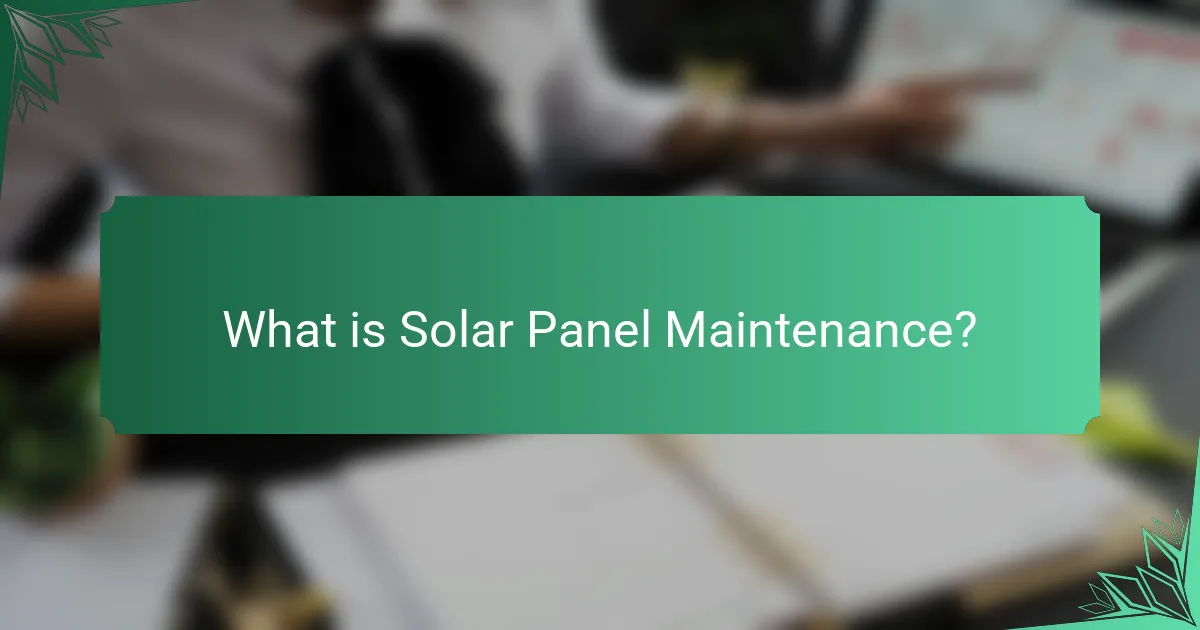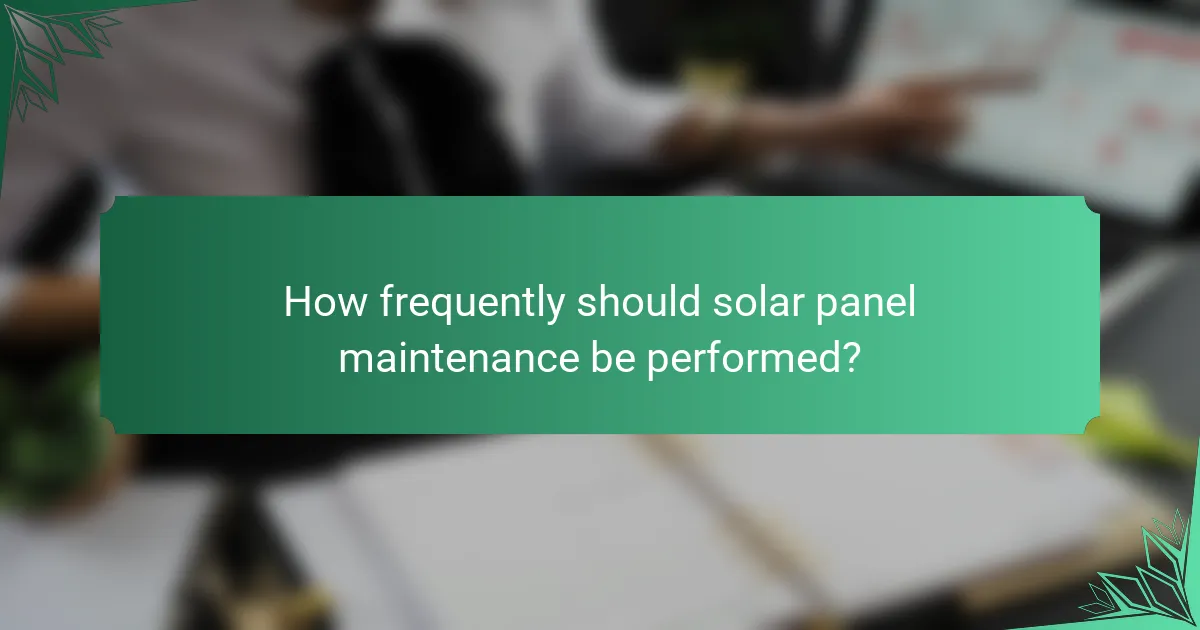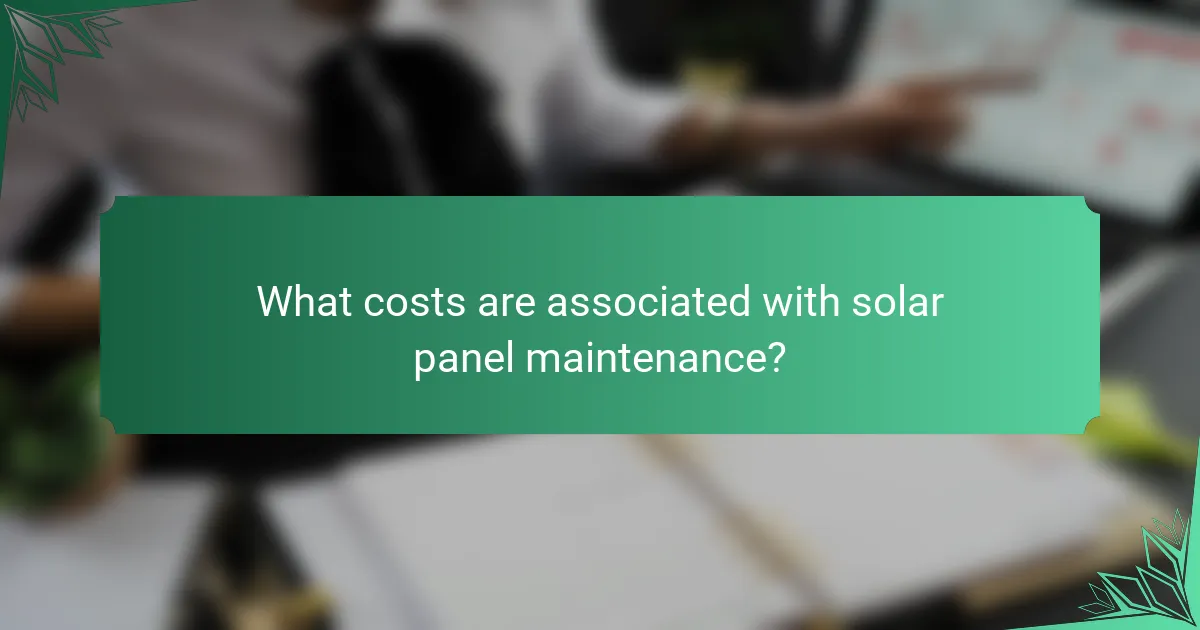
What is Solar Panel Maintenance?
Solar panel maintenance refers to the regular care and upkeep of solar panels to ensure optimal performance. This process includes cleaning the panels to remove dirt and debris. It also involves inspecting for any physical damage or wear. Regular maintenance can enhance the efficiency of solar energy production. According to the U.S. Department of Energy, properly maintained solar panels can last 25 years or more. Routine checks can help identify issues early, preventing costly repairs. Overall, effective maintenance is crucial for maximizing the lifespan and effectiveness of solar energy systems.
Why is Solar Panel Maintenance important?
Solar panel maintenance is important to ensure optimal performance and longevity. Regular maintenance prevents efficiency loss caused by dirt, debris, and shading. Cleaning panels can increase energy output by up to 25%. Inspections identify potential issues like cracks or electrical faults early. Addressing these problems promptly can avoid costly repairs. Well-maintained solar systems can last 25 years or more. This longevity maximizes return on investment for homeowners. Studies show that neglected panels can underperform significantly, impacting energy savings.
What are the potential risks of neglecting maintenance?
Neglecting maintenance of solar panels can lead to decreased efficiency and increased costs. Over time, dirt and debris can accumulate on the panels, reducing their ability to absorb sunlight. This can result in a significant drop in energy production, sometimes by 20% or more. Additionally, failing to inspect for damage can lead to more severe issues, such as electrical faults or system failures. These problems may require costly repairs or replacements. Regular maintenance helps identify such issues early, preventing further damage and ensuring optimal performance. Studies show that properly maintained solar panels can achieve up to 30% higher efficiency over their lifespan.
How does maintenance impact the efficiency of solar panels?
Maintenance significantly impacts the efficiency of solar panels. Regular cleaning removes dirt and debris that can block sunlight. This blockage reduces the panels’ ability to convert solar energy into electricity. Additionally, routine inspections can identify and address issues like wiring problems or equipment malfunctions. According to the National Renewable Energy Laboratory, well-maintained solar panels can operate at up to 25% higher efficiency than poorly maintained ones. Therefore, consistent maintenance is essential for optimal performance and energy output.
What are the common practices for maintaining solar panels?
Common practices for maintaining solar panels include regular cleaning and inspection. Cleaning removes dirt and debris that can block sunlight. Ideally, panels should be cleaned every six months or after major storms. Inspections help identify any damage or wear. Checking for loose connections and corrosion is essential. Monitoring performance through the inverter can indicate issues. Additionally, ensuring proper shading and vegetation management supports efficiency. Following these practices can enhance the lifespan and performance of solar panels.
How often should solar panels be cleaned?
Solar panels should be cleaned at least twice a year. This frequency helps maintain optimal efficiency and energy production. Dust, dirt, and debris can accumulate on the panels, reducing their effectiveness. In areas with heavy rainfall, natural cleaning may suffice. However, in drier climates, more frequent cleaning may be necessary. Some studies suggest that cleaning can improve energy output by up to 20%. Regular maintenance ensures the longevity and performance of solar panels.
What tools and materials are needed for effective maintenance?
Effective maintenance of solar panels requires specific tools and materials. Essential tools include a soft-bristle brush for cleaning, a hose for rinsing, and a multimeter for electrical testing. A voltage tester is also necessary to ensure safety during maintenance. Additionally, safety gear such as gloves and goggles is important to protect the technician. For materials, biodegradable soap is recommended for cleaning without harming the environment. Regular inspections may also require a ladder for accessing elevated panels. Having these tools and materials ensures efficient and safe maintenance of solar panels.

How frequently should solar panel maintenance be performed?
Solar panel maintenance should be performed at least twice a year. Regular inspections help identify issues early. Cleaning the panels is also recommended to maximize efficiency. Dust, dirt, and debris can reduce energy output. Additionally, checking for damages or wear is crucial. This proactive approach ensures optimal performance and longevity. Industry guidelines support this maintenance frequency for best results.
What factors influence the frequency of maintenance?
The frequency of maintenance for solar panels is influenced by several key factors. These factors include environmental conditions, panel type, and installation location. Environmental conditions such as dust, debris, and bird droppings can increase the need for cleaning and maintenance. The type of solar panel also plays a role; some panels require more frequent checks than others. Additionally, the installation location impacts maintenance frequency; areas with heavy rainfall or snow may require less frequent inspections compared to arid regions. Regular monitoring of performance metrics can also dictate maintenance needs. Research indicates that regular maintenance can enhance the efficiency and lifespan of solar panels, making timely upkeep essential.
How does the local climate affect maintenance schedules?
Local climate significantly influences solar panel maintenance schedules. In regions with heavy snowfall, maintenance may require more frequent checks to clear snow buildup. Conversely, areas with high dust or pollen levels necessitate regular cleaning to maintain efficiency. Humid climates can lead to mold growth, requiring additional inspections and cleaning. Extreme temperatures can affect the integrity of solar panel components, prompting more regular maintenance checks. For example, studies indicate that solar panels in hot climates may experience reduced efficiency, necessitating more frequent performance monitoring. Overall, adapting maintenance schedules to local climate conditions ensures optimal solar panel performance and longevity.
What role does the installation environment play in maintenance frequency?
The installation environment significantly impacts maintenance frequency for solar panels. Factors such as location, climate, and surrounding vegetation influence how often maintenance is required. For example, panels installed in dusty or sandy areas may require more frequent cleaning to maintain efficiency. Similarly, regions with heavy rainfall may see less dust accumulation but could face issues with debris or mold. Additionally, proximity to trees can lead to shading and leaf buildup, necessitating regular inspections and cleaning. Studies indicate that solar panels in harsh environments may need maintenance every six months, while those in milder climates could require it annually. This variability underscores the importance of assessing the installation environment when planning maintenance schedules.
What are the recommended seasonal maintenance checks?
Recommended seasonal maintenance checks for solar panels include inspecting for debris and dirt accumulation. Cleaning the panels enhances efficiency by allowing maximum sunlight absorption. Checking the mounting systems is crucial to ensure stability and proper alignment. Inspecting electrical connections prevents potential hazards and ensures optimal performance. Monitoring the inverter’s performance helps identify any operational issues. Additionally, reviewing the system’s output against expected performance benchmarks is essential for assessing efficiency. Regular seasonal checks can extend the lifespan of solar panels and maintain energy production.
What should be inspected during spring maintenance?
During spring maintenance, solar panels should be inspected for dirt, debris, and shading. Cleaning the panels enhances their efficiency. Inspecting for any physical damage is crucial. Check for cracks or loose connections in the wiring. Ensure that the mounting system is secure and free from corrosion. Evaluate the inverter for proper operation and any error codes. Lastly, review the overall performance metrics to identify any drops in energy production. Regular inspections can lead to optimal performance and longevity of the solar system.
How can winter conditions affect solar panel performance?
Winter conditions can significantly affect solar panel performance. Cold temperatures can improve the efficiency of solar panels. However, snow accumulation can block sunlight and reduce energy production. Ice can also create a barrier that prevents sunlight from reaching the panels. Additionally, shorter daylight hours in winter limit the amount of solar energy available. According to the U.S. Department of Energy, solar panels can still generate electricity in cloudy or snowy conditions, but at reduced levels. Regular maintenance is essential to remove snow and ice for optimal performance.

What costs are associated with solar panel maintenance?
The costs associated with solar panel maintenance include cleaning, inspections, and repairs. Cleaning solar panels typically costs between $15 to $30 per panel. Regular inspections can range from $100 to $300 annually, depending on the system size. Repairs for malfunctioning components may vary significantly, averaging $200 to $1,000. Additionally, inverter replacements can cost between $1,000 to $3,000, depending on the brand and type. Overall, annual maintenance costs can average between $300 to $800 for a standard residential solar system.
What are the typical expenses for DIY maintenance?
Typical expenses for DIY solar panel maintenance include cleaning supplies, tools, and safety equipment. Cleaning supplies may cost around $20 to $50 for specialized solar panel cleaners. Tools such as a soft brush or squeegee can range from $10 to $30. Safety equipment, including gloves and goggles, typically costs about $15 to $40. Additionally, if repairs are needed, replacement parts can vary significantly. Minor repairs may cost $50 to $200, depending on the component. Overall, DIY maintenance expenses can range from $100 to $300 annually, depending on the specific tasks performed.
How can homeowners save on maintenance costs?
Homeowners can save on maintenance costs by implementing regular inspections and cleaning of solar panels. Regular maintenance helps identify issues early, preventing costly repairs. Homeowners should also monitor their energy output to detect any performance drops. Utilizing manufacturer warranties can cover specific maintenance costs, reducing out-of-pocket expenses. Additionally, homeowners can invest in high-quality solar panels that require less frequent maintenance. Following these practices can lead to significant long-term savings on maintenance costs.
What are the hidden costs of neglecting maintenance?
Neglecting maintenance of solar panels incurs hidden costs such as reduced efficiency and higher energy bills. Over time, dirt and debris accumulate, obstructing sunlight and decreasing energy production by up to 20%. This inefficiency leads to increased reliance on grid power, raising monthly electricity expenses. Additionally, lack of maintenance can result in equipment damage, necessitating costly repairs or replacements. For instance, a study by the National Renewable Energy Laboratory indicates that regular maintenance can extend the lifespan of solar panels by 25%. Neglect can also void warranties, leading to out-of-pocket expenses for repairs. Overall, the long-term financial impact of neglecting solar panel maintenance can significantly outweigh the upfront maintenance costs.
What are the costs of hiring professional maintenance services?
The costs of hiring professional maintenance services for solar panels typically range from $150 to $500 per visit. This cost can vary based on the size of the solar system and the specific services required. Basic inspections may be on the lower end of the scale, while comprehensive maintenance, including cleaning and repairs, may incur higher fees. According to the Solar Energy Industries Association, regular maintenance can enhance the efficiency and lifespan of solar panels, justifying the investment. Additionally, many companies offer annual maintenance packages that can reduce long-term costs.
What services are typically included in a maintenance contract?
Maintenance contracts for solar panels typically include inspections, cleaning, and repairs. Inspections ensure that the solar panels are functioning correctly and efficiently. Cleaning removes dirt and debris that can block sunlight. Repairs address any issues that may arise, such as damaged panels or wiring. Additional services may include monitoring system performance and providing performance reports. These services help maintain optimal energy production and extend the lifespan of the solar system. Regular maintenance can prevent costly repairs and ensure compliance with warranties.
How do service costs vary by region?
Service costs for solar panel maintenance vary significantly by region due to factors like labor rates, local regulations, and market demand. In urban areas, costs are generally higher due to increased labor expenses and competition. Conversely, rural regions may have lower service costs due to reduced demand and lower living expenses. For example, maintenance services in California can range from $150 to $300, while in states like Texas, costs might be between $100 and $200. Additionally, regional incentives and rebates can influence overall maintenance costs. Areas with strong solar initiatives often see more competitive pricing due to increased service provider availability.
What are the best practices for effective solar panel maintenance?
Regular cleaning of solar panels is essential for effective maintenance. Dust, dirt, and debris can reduce their efficiency. Cleaning should be done at least twice a year. Use a soft brush or sponge with mild soap and water. Avoid harsh chemicals that could damage the panels. Inspect the panels for cracks or damage during cleaning. Ensure that the mounting hardware is secure. Monitor the system’s performance to detect any issues early. Professional inspections can be beneficial annually. These practices help maintain optimal energy production and prolong the lifespan of solar panels.
How can regular inspections enhance solar panel longevity?
Regular inspections enhance solar panel longevity by identifying and addressing issues early. These inspections can detect dirt, debris, or damage that may hinder performance. Regular checks also ensure that connections are secure and components are functioning correctly. By maintaining optimal conditions, solar panels can operate efficiently for longer periods. Research shows that well-maintained solar panels can last up to 25 years or more. This longevity is crucial for maximizing return on investment. Regular inspections are an essential part of proactive maintenance strategies. They help prevent costly repairs and replacements in the long run.
What are the most common troubleshooting tips for solar panel issues?
Check for dirt or debris on the solar panels. Cleaning them can improve efficiency. Inspect the wiring for any signs of damage. Damaged wiring can lead to power loss. Ensure that the inverter is functioning properly. A faulty inverter can stop energy conversion. Monitor the system’s performance regularly. Sudden drops in output may indicate issues. Verify that the solar panels are properly angled. Incorrect angles can reduce sunlight exposure. Check for shading from nearby objects. Shade can significantly decrease panel efficiency.
Solar panel maintenance is the systematic upkeep of solar panels to ensure their optimal performance and longevity. This article covers essential practices for maintaining solar panels, including regular cleaning and inspections, and emphasizes the importance of addressing potential issues to prevent costly repairs. It highlights the recommended frequency of maintenance, the impact of local climate and installation environment on maintenance schedules, and the associated costs, including DIY and professional services. Key insights on best practices and troubleshooting tips are also provided, aimed at maximizing energy production and extending the lifespan of solar energy systems.